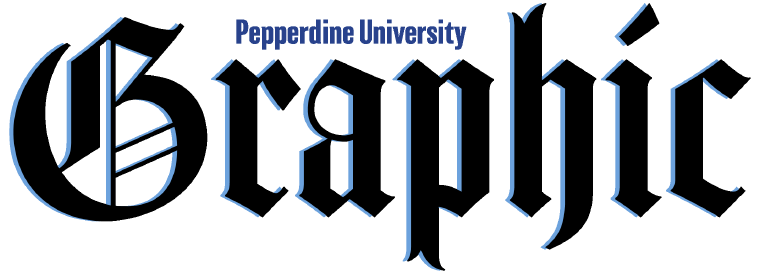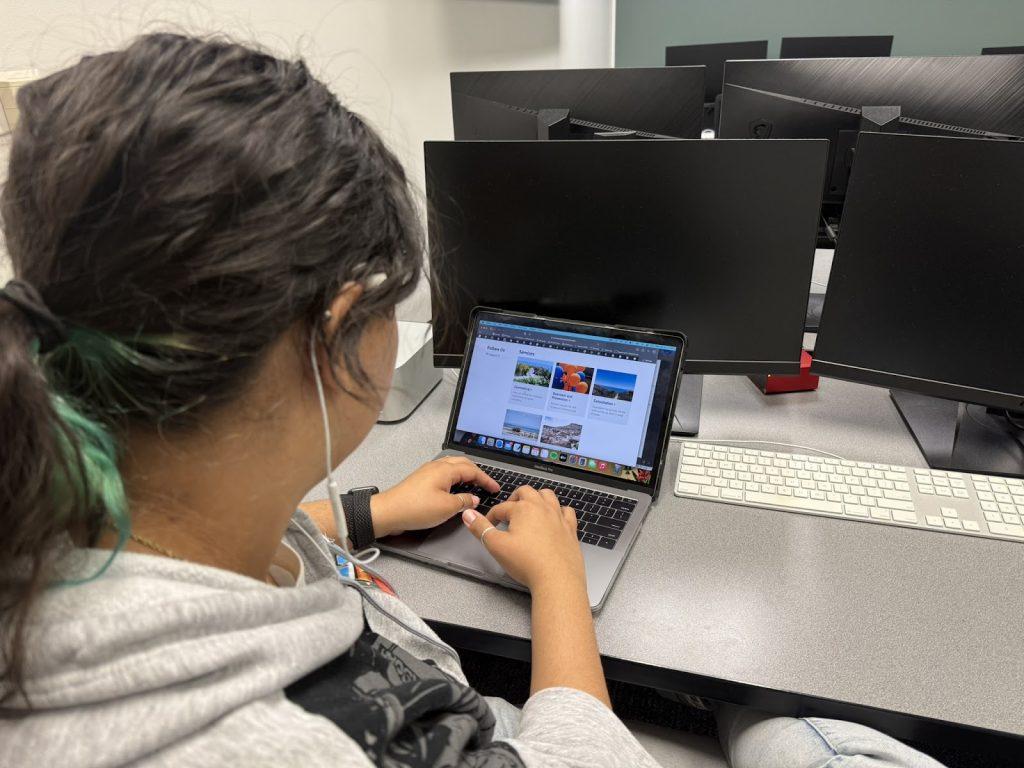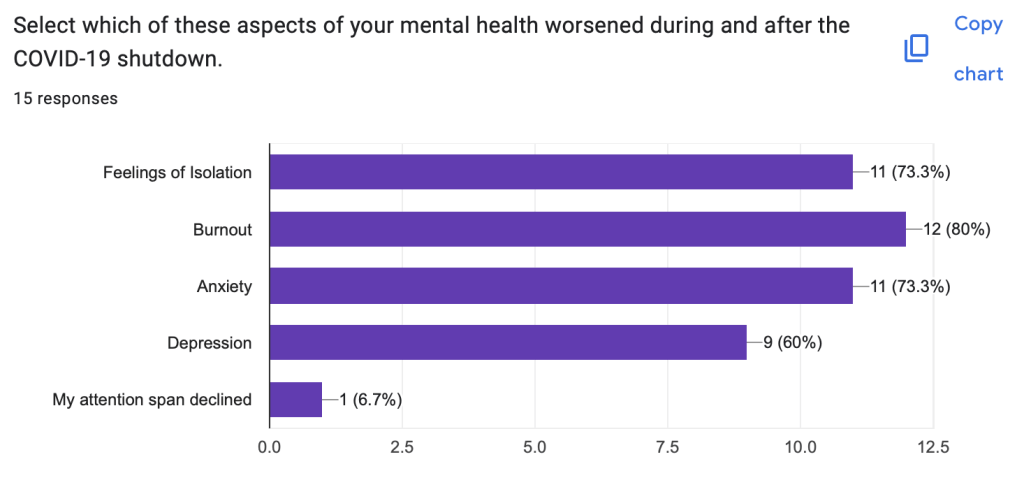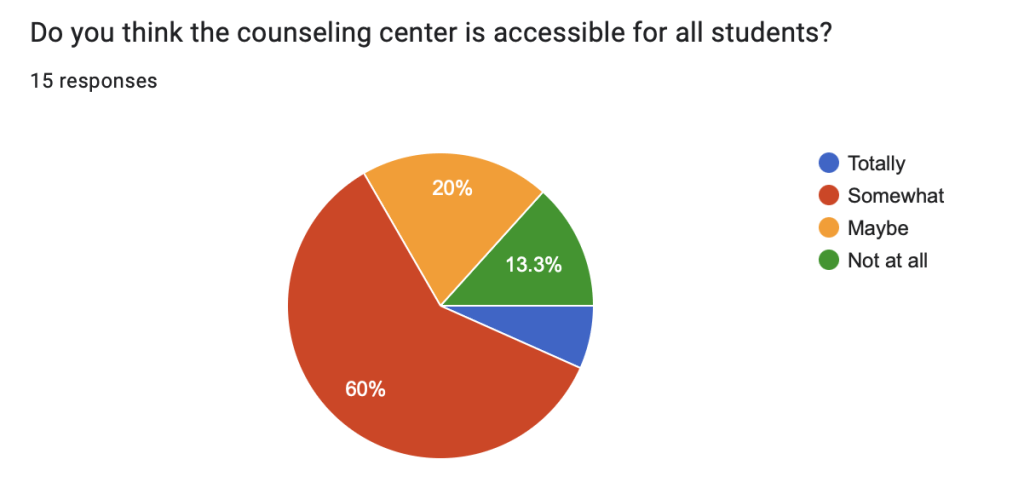Alumna Hailey Ponchione (’25) browses the Pepperdine Counseling Center website April 21. Some students said they find the Counseling Center’s service offerings to be inaccessible to students on campus. Photo by Amanda Monahan
March 13, 2020: the date the world shut down, classes went online and social interactions became sparse.
Just over five years after the global shutdown due to the COVID-19 pandemic, life feels seemingly “normal” again in most capacities. However, in higher education institutions across the world, mental health remains an intense problem.
Global prevalence of anxiety and depression increased by 25% in the first year of the COVID-19 pandemic, according to a 2022 study by the World Health Organization.
“Never before in my career have I known so many people who just seem as burned out as faculty, staff and students are today,” Psychology Professor Steve Rouse said.
Though mental health issues among young adults existed far before the pandemic, these issues only worsened as a result of the shutdown, said Connie Horton, vice chancellor for the RISE Institute.
Pepperdine students said they have noticed a shift in their mental health during the pandemic and in its aftermath. However, the main issue lies in what to do next. Students have concerns regarding the University’s mental health resources and whether there are enough accessible options for the diversity of student needs on campus.
Alumna Kyra Hatton (’25), former SWAB co-president, said post-pandemic wellness services have changed in offerings.
“When Pepperdine shifted back onto campus, there was really a need for a more holistic approach to health and wellness,” Hatton said. “Obviously the pandemic was huge for physical health, but the isolation that came with it deeply affected both mental and community health.”
The Problem
Before the start of the pandemic, roughly 36% of college students were experiencing mental illness, according to a 2024 Best Colleges article.
The percentage has jumped to 60% of college students who now report a variety of mental illnesses, including anxiety, depression and general feelings of loneliness, according to the American Psychiatric Association.
Student responses show mental health effects of the COVID-19 pandemic in an April 2025 survey. Nearly all students who answered the survey reported feelings of isolation, burnout, anxiety and depression during and after the COVID-19 pandemic.
Horton said as busy college students, it can be difficult to feel it is even worth it to seek help for mental health. When schedules are busy and deadlines are approaching, taking time away from work is often the last thing on students’ minds.
“You have to decide, it’s like getting your head above water sometimes when you’re really busy or really depressed or really anxious,” Horton said. “You’re like, ‘I can’t make it over there right now,’ but that’s when you really need to.”
Horton said remembering the “quilt of care” that exists at Pepperdine is important for students. Resident advisors and resident directors have a fair amount of training on these topics, who can serve as a first set of eyes and ears for support among professors and other faculty.
However, for some faculty, being there for students can be difficult when no one is there for them.
Chris Doran, professor of Religion and Sustainability and the Seaver Faculty Senate president during the COVID-19 pandemic, said he heard a wide range of concerns from faculty throughout the time of online learning.
Doran said many faculty members voiced issues with being on Zoom all day, having family members with COVID-19, taking care of kids at home, issues of social unrest across the United States and more, often without receiving any support from the University.
“I took a lot of Zoom calls with people who were kind of thinking about whether they were going to stay or go or what did that mean in a time of social unrest across the country,” Doran said. “Not just because of COVID, but because of these other social events that were going on as well, and then trying to balance that with your home life.”
Doran said Pepperdine provided significant care to students, yet he saw that allocation to be heavily unfavorable toward faculty.
“While I applaud the University for putting so much energy into making sure our students were OK, I wish they had put even just a small amount of that energy into making sure their faculty were OK,” Doran said.
During this time, Doran said because he received a lack of help from administration and the University. He sought out resources to find what other schools were doing to help their faculty.
Doran said he and the Seaver Faculty Senate then implemented a survey for faculty, in which the survey collected data about faculty needs at the time and what kind of help they desired.
Similar to the feelings of students, Doran said the survey revealed a sharp decline in overall well-being for faculty during this time.
“We found that whether spiritual health, mental health, physical, emotional health — all of those things were tremendously down during that time,” Doran said.
Doran took this survey data to administration, and he said some were receptive while others were not. Ultimately, his goal was to find a way for faculty to receive even a fraction of the support students were receiving, a battle that continues today, five years later.
“Even a couple years afterwards, I’m still struggling to understand you know, when something comes up, why are we not seeing that faculty health and welfare is just as important as student health and welfare,” Doran said.
Pepperdine’s Current Resources
Pepperdine offers mental health and counseling resources for students and faculty on campus. But students often raise the question of whether there are enough.
Chiconia Anderson, adjunct professor of Psychology and licensed marriage and family therapist, said Pepperdine adopted a resource known as Telehealth during the COVID-19 pandemic that has since stuck around.
“Zoom really kind of boomed and blossomed during that time. So being able to switch over and be able to say, ‘Hey, we’ll meet you,’” Anderson said. “During this particular time we had after-hour calls because we knew people were in different time zones. We had international students — that’s a 12-hour time difference. We definitely came together and did a lot more Telehealth at that time.”
Telehealth has been immensely helpful in the medical world for connecting patients and licensed professionals, despite the problem of space and time, Anderson said. It is also still an option for students and faculty to meet via Zoom for a Telehealth appointment with the Pepperdine Counseling Center, even in the post-COVID-19 era.
During COVID-19, the Counseling Center also added TimelyCare to Pepperdine’s resources available to students in need of support, Horton said.
TimelyCare is an app designed to help busy college students stay on top of their mental health with all of the stressors of college life. However, it has not been very useful to Pepperdine students.
“Telehealth became more common during the pandemic,” Hatton said. “TimelyCare is a new initiative under the Thrive Student Wellness Program and it was another shift towards Telehealth since our student body is spread out.”
Student responses show views on the Counseling Center’s accessibility on campus. A majority of students said they find the Counseling Center only to be “somewhat accessible.”
Student responses to an April survey revealed students seek counseling or mental health resources outside of Pepperdine, for various reasons including “they [outside resources] better fit my needs” and “they [the Counseling Center] ghosted me.”
As far as other resources and outreach programs Pepperdine offers to support its students and faculty on campus, the Counseling Center has different support and focus groups that partner with our graduate campuses, such as the Graduate School of Education and Psychology (GSEP).
Anderson said they are always looking for ways to add to their outreach and resources and that they value students’ feedback immensely when conducting end-of-the-year audits.
“There’s always room for improvement and I love learning what other campuses do and things like that,” Anderson said. “There’s a possibility for growing. Obviously we have to wait for budget. Absolutely, we could grow as a community.”
Anderson said she has looked to other universities for possible resources to implement at Pepperdine.
“Maybe have more counselors,” Anderson said. “Maybe, like the University of Houston, they actually have a counselor in each school. So like the business schools, at law school, just one, and then they also work back at the main counseling center.”
The Resilience-Informed Skills Education Program (RISE) got its start right around the same time as the shutdown, which has proven to help many community members who have attended the events both during the pandemic and since, Horton said.
UCSB’s Mental Health Solution
Looking beyond Pepperdine, University of California, Santa Barbara (UCSB) has implemented its Mental Health Peer Program as a solution for the lingering effects the pandemic has left on the mental health of college students, according to UCSB’s website.
Gladys Koscak, director of Health & Wellness at UCSB, said she saw a sizable increase in isolation and anxiety in students post-pandemic.
“The things that have been the most striking to me are anxiety levels,” Koscak said. “But the things we hear quite often in our therapy room are just the isolation and the loneliness pieces.”
This is where the Peer Program comes into play.
Koscak said they train undergraduate students to consult in peer counseling, which involves therapy sessions, group sessions and community outreach.
“Mentoring mental health peers through this job has been one of the most fulfilling aspects of my entire professional career,” Koscak said. “It’s such a unique experience for our students to be able to provide that level of service as an undergraduate.”
Koscak said the drop-in peer counseling has been the most effective tool the program offers in combating the lingering impacts of the COVID-19 shutdown because it gives students who are hesitant a space to try counseling services that feel more personable.
“Being able to provide a space for students that would never step into a counseling center and being able to bridge that gap feels really meaningful to me,” Koscak said.
The Peer counselors and Koscak implement their knowledge of the impacts of the COVID-19 shutdown into their program, Koscak said.
“We try to educate people around the impacts that COVID times did have,” Koscak said.
Some of those impacts include reliance on devices and being limited to face-to-face interactions.
“Our brains light up differently with an interaction through a device versus in person,” Koscak said.
Koscak said the peer program aims to provide fully in-person events where students can be pushed out of their comfort zone and gain connection with their peers.
Senior UCSB student Le Anh Metzger said she prioritizes in-person interactions like this to strengthen her relationships.
A limitation to this program, as well as most mental health outreach, is they don’t do long-term follow ups, Koscak said.
“It’s meant to be a therapeutic relationship,” Koscak said. “So we only get a little snapshot of their experiences while they’re in the room.”
But, students have come back to Koscak and her team grateful for their services.
“We certainly have had people come back and have thanked us for giving them that space,” Koscak said.
Future Implementation at Pepperdine
A large barrier in students seeking resources on campus is the lack of communication, Horton said. Many students are unaware of the plethora of available resources.
“They [students] maybe sort of heard but didn’t need it at the time or they didn’t think they needed it, or they sort of thought about it but they were just, ‘Oh, there was something,’” Horton said. “And certainly, there’s some people who have a lot of anxiety and stigma and concern about the taboo.”
Horton acknowledged other campuses, such as UCSB, have more specialized centers for mental health resources. However, as a small, private institution, having specialized resources can be a bit trickier, she said.
A positive implementation Horton has seen across other universities is the idea of a “live in” or “residential” counselor, she said. These counselors primarily serve as crisis response, but also have an added level of accessibility in that they live in the residence halls with students.
“It would be nice if we could have that kind of support,” Horton said. “We have our own way of doing crisis response, but if the students were already used to you know, I see that guy around, or that woman, or I see their family, and now I’d like to explore this workshop they’re offering in the residence hall.”
Five years post-pandemic, there is still a major lack of resources for faculty in regards to mental health at Pepperdine.
“We take feedback really seriously,” Hatton said. “We appreciate it because it helps us understand exactly what the needs of students are and ultimately our goal is to meet the student body where they’re at and get them access to the resources they need.”
The University of California system offers free, confidential emotional support for all of its faculty and staff members, which are implemented across all of its schools. Additionally, the University of Southern California offers a wide variety of resources for faculty and staff, including programs for intervention, spiritual life free counseling and more, according to the University’s website.
Although Pepperdine has less mental health support resources for faculty, RISE is a good first step forward, Horton said. The program offers specialized events just for faculty, as well as education in being there for students or incorporating resilience across other areas of life.
Rouse said he recognizes where RISE attempts to make mental health resources available for faculty and staff, but explains there are limitations.
“The RISE program also does have programs for faculty and staff,” Rouse said. “But I get a sense that a lot of faculty and staff just feel like they’re too busy keeping all the dishes spinning in the air to take some time off to also go to a RISE program.”
Koscak said in situations where students feel fear around the stigma regarding mental health, a program like UCSB’s Peer Program could prove immensely helpful in combating this stigma.
In survey responses, many students said they turn to their roommates and friends more often than the counseling center for mental health support, suggesting that a program in which students can talk to “trained peers” could better fit the needs of the student body post-COVID-19.
__________________
Follow the Graphic on X: @PeppGraphic
Contact Amanda Monahan by email: amanda.monahan@pepperdine.edu
Contact Haylie Ross by email: haylie.ross@pepperdine.edu
Contact Isabella Pisciotta by email: isabella.pisciotta@pepperdine.edu
Contact Alicia Stadler by email: alicia.stadler@pepperdine.edu




